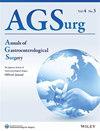Assessing Intra-abdominal status for clinically relevant postoperative pancreatic fistula based on postoperative fluid collection and drain amylase levels after distal pancreatectomy
Abstract
Aim
The aim of this study was to evaluate the intra-abdominal status related to postoperative pancreatic fistula by combining postoperative fluid collection and drain amylase levels.
Methods
We retrospectively reviewed the data of 203 patients who underwent distal pancreatectomy and classified their postoperative abdominal status into four groups based on postoperative fluid collection size and drain amylase levels. We also evaluated the incidence of clinically relevant postoperative pancreatic fistula in each group according to C-reactive protein values.
Results
The incidence of clinically relevant postoperative pancreatic fistula in the entire cohort (n = 203) was 28.1%. Multivariate analysis revealed that postoperative fluid collection, drain amylase levels, and C-reactive protein levels are considerable risk factors for clinically relevant postoperative pancreatic fistula. In the subgroup with large postoperative fluid collection and high drain amylase levels, 65.9% of patients developed clinically relevant postoperative pancreatic fistula. However, no significant difference was observed in C-reactive protein levels between patients with clinically relevant postoperative pancreatic fistula and those without it. In contrast, in the subgroup with a large postoperative fluid collection size or a high amylase level alone, a significant difference was observed in C-reactive protein values between the patients with clinically relevant postoperative pancreatic fistula and those without it.
Conclusion
Postoperative fluid collection status and the C-reactive protein value provide a more precise assessment of intra=abdominal status related to postoperative pancreatic fistula after distal pancreatectomy. This detailed analysis may be a clinically reasonable approach to individual drain management.


 求助内容:
求助内容: 应助结果提醒方式:
应助结果提醒方式:


